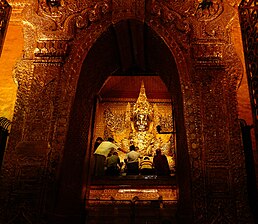
Back Mandalay Afrikaans ماندالاي Arabic ماندالاى ARZ Mandalay Azerbaijani Мандалай Byelorussian Мандалай BE-X-OLD Мандалей Bulgarian ဝေင်ꩻမန်ႏတလေꩻ BLK মান্দালয় Bengali/Bangla Mandalay Breton
Mandalay
မန္တလေး | |
|---|---|
City | |
From top: Mahamuni Buddha Temple, cultural conservation zones around Mandalay Hill, U Bein Bridge, Zegyo Market, Mandalarthiri Stadium, the Mandalay Palace | |
 | |
| Coordinates: 21°58′59″N 96°05′04″E / 21.98306°N 96.08444°E | |
| Country | |
| Region | Mandalay Region |
| District | Mandalay District |
| Founded | 1857 |
| Founded by | King Mindon |
| Government | |
| • Mayor | Kyaw San |
| Area | |
• City | 163.84 km2 (63.26 sq mi) |
| Elevation | 22 m (70 ft) |
| Population | |
• City | 1,726,889 |
| • Density | 11,000/km2 (27,000/sq mi) |
| • Urban | 1,319,452 (76%) |
| • Rural | 407,437 (24%) |
| • Ethnic groups | Bamar Chinese Shan & other minorities |
| • Religions | Theravada Buddhism Christianity Hinduism Islam |
| Demonym | Mandalayan |
| Time zone | UTC+6:30 (MMT) |
| Area code | 02[3] |
| Vehicle registration | MDY |
Mandalay (/ˌmændəˈleɪ/ or /ˈmændəleɪ/; Burmese: မန္တလေး; MLCTS: manta.le: [màndəlé]) is the second-largest city in Myanmar, after Yangon. Located on the east bank of the Irrawaddy River, 631 km (392 miles; road distance) north of Yangon, the city has a population of 1,225,553 (2014 census).
Mandalay was founded in 1857 by King Mindon, replacing Amarapura as the new royal capital of the Konbaung dynasty. It was Burma's final royal capital before the kingdom's annexation by the British Empire in 1885. Under British rule, Mandalay remained commercially and culturally important despite the rise of Yangon, the new capital of British Burma. The city suffered extensive destruction during the Japanese conquest of Burma in the Second World War. In 1948, Mandalay became part of the newly independent Union of Burma.
Today, Mandalay is the economic centre of Upper Myanmar and considered the centre of Burmese culture. A continuing influx of irregular Chinese immigrants, mostly from Yunnan, since the late 20th century, has reshaped the city's ethnic makeup and increased commerce with China.[4][5][dead link] Despite Naypyidaw's recent rise, Mandalay remains Upper Myanmar's main commercial, educational and health center.
- ^ "Water Purification Plant No. 8 in Aungmyethazan Township 60% Complete". Bi-Weekly Eleven (in Burmese). Eleven Media Group. 28 April 2011.
- ^ Census Report. The 2014 Myanmar Population and Housing Census. Vol. 2. Naypyitaw: Ministry of Immigration and Population. May 2015. p. 57. Retrieved 26 April 2017.
- ^ "Myanmar Area Codes". Archived from the original on 1 December 2009. Retrieved 10 April 2009.
- ^ Cite error: The named reference
iisswas invoked but never defined (see the help page). - ^ Cite error: The named reference
jtwas invoked but never defined (see the help page).








